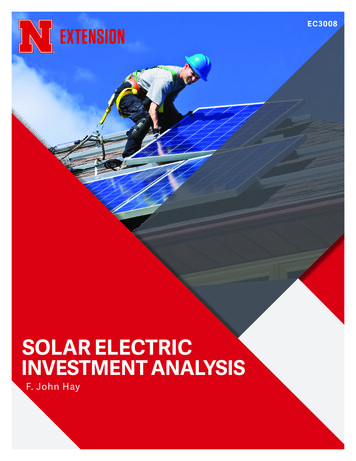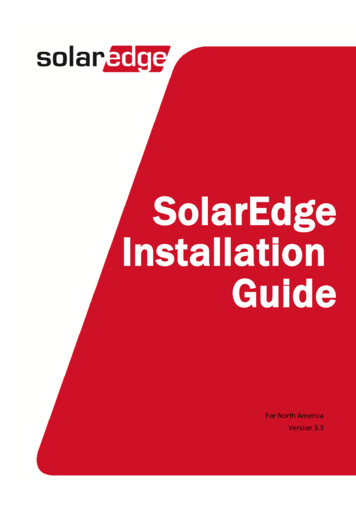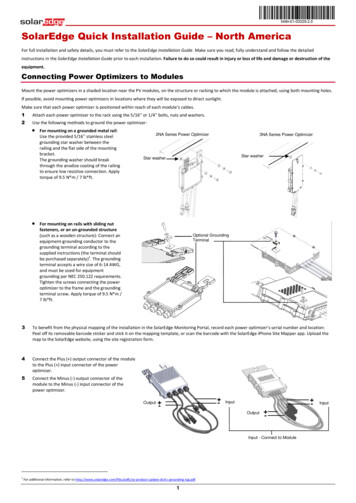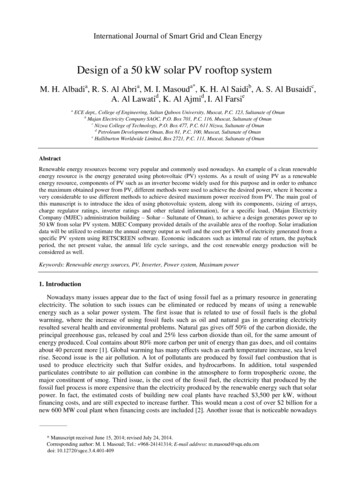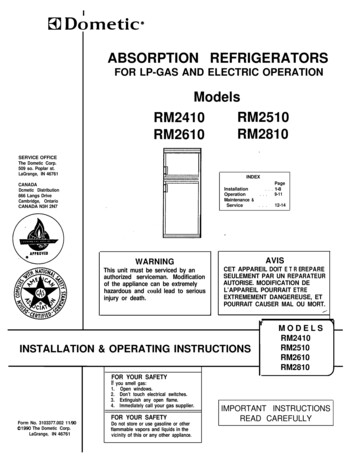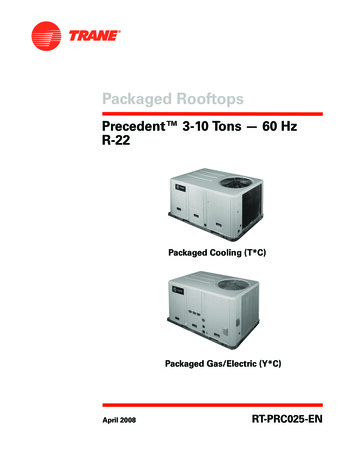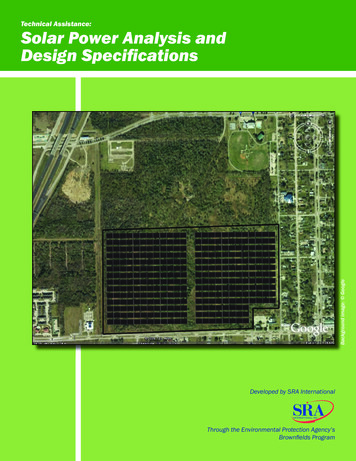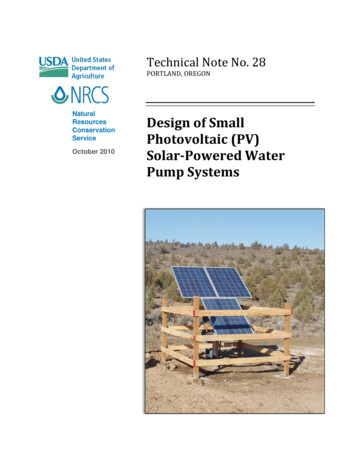
Transcription
Solar Electric System Design,Operation and InstallationAn Overview for Builders in the U.S. Pacific NorthwestOctober 2009
Solar Electric SystemDesign, Operation and InstallationAn Overview for Builders in the Pacific NorthwestOctober 2009 2009 Washington State University Extension Energy Program905 Plum Street SE, Bldg 3Olympia, WA 98504-3165www.energy.wsu.eduThis publication contains material written and produced for public distribution.Permission to copy or disseminate all or part of this material is granted, provided that thecopies are not made or distributed for commercial advantage and that they arereferenced by title with credit to the Washington State University Extension EnergyProgram.WSUEEP09-013
AcknowledgmentsThe primary author of this overview was Carolyn Roos, Ph.D., of the Washington StateUniversity Extension Energy Program. Mike Nelson of the Northwest Solar Centerprovided very helpful consultation and a detailed review of several drafts. KaciaBrockman of the Energy Trust of Oregon also provided very insightful review comments.This publication was adapted and updated from one prepared for the Energy Trust ofOregon, Inc. in 2005.DisclaimerWhile the information included in this guide may be used to begin a preliminary analysis,a professional engineer and other professionals with experience in solar photovoltaicsystems should be consulted for the design of a particular project.Neither Washington State University nor its cooperating agencies, nor any of theiremployees, makes any warranty, express or implied, or assumes any legal liability orresponsibility for the accuracy, completeness or usefulness of any information, apparatus,product, or process disclosed, or represents that its use would not infringe privatelyowned rights. Reference herein to any specific commercial product, process, or serviceby trade name, trademark, manufacturer, or otherwise does not necessarily constitute orimply its endorsement, recommendation, or favoring by Washington State University orits cooperating agencies.iii
ContentsIntroduction . 1Evaluating a Site for Solar PV Potential. 2Photovoltaic System Types. 5System Components. 8Solar Modules . 8Array Mounting Racks . 11Grounding Equipment. 12Combiner Box . 13Surge Protection. 13Meters and Instrumentation. 13Inverter . 14Disconnects. 16Battery Bank. 17Charge Controller . 18Putting the System Together . 20The Project Team. 20The NEC and PV Systems . 21Safety During the Installation . 21Special Considerations in Wiring PV Systems . 22System Design Considerations. 23System Considerations . 23Design Resources. 23Cost Considerations . 25For More Information – References . 26Acronyms and Abbreviations . 29List of FiguresFigure 1. One common configuration of a grid-connected AC photovoltaicsystem without battery back-up . 6Figure 2. One common configuration of a grid-connected AC photovoltaicsystem with battery back-up . 7iv
IntroductionAs the demand for solar electric systems grows, progressive builders are adding solarphotovoltaics (PV) as an option for their customers. This overview of solar photovoltaicsystems will give the builder a basic understanding of: Evaluating a building site for its solar potentialCommon grid-connected PV system configurations and componentsConsiderations in selecting componentsConsiderations in design and installation of a PV systemTypical costs and the labor required to install a PV systemBuilding and electric code requirementsWhere to find more informationEmphasis will be placed on information that will be useful in including a grid-connectedPV system in a bid for a residential or small commercial building. We will also coverthose details of the technology and installation that may be helpful in selectingsubcontractors to perform the work, working with a designer, and directing work as itproceeds. A summary of system types and components is given so the builder will knowwhat to expect to see in a design submitted by a subcontractor or PV designer.In 2008, the installed cost of a residential PV system in the United States typically rangedfrom 8 to 10 per installed watt before government or utility incentives. For more detailon costs, see the section titled “Cost Considerations.” For information on puttingtogether your installation team, refer to the section “The Project Team.”1
Evaluating a Site for Solar PV PotentialDoes the Pacific Northwest Have Good Solar Potential? – This is a very commonquestion and the answer is, yes, the Pacific Northwest gets enough sun for grid-connectedphotovoltaic systems to operate well. The Northwest’s highest solar potential is east ofthe Cascades. But even west of the Cascades, the Oregon’s Willamette Valley receivesas much solar energy annually as the U.S. average – as much over the course of the yearas southern France and more than Germany, the current leader in solar electricinstallations. Under cloudy conditions, it is true that photovoltaics produce only 5 to 30percent of their maximum output. However, because solar photovoltaics become lessefficient when hot, our cooler climate and our long summer days help make up for thecloudy days.Evaluating a Building Site – While the Pacific Northwest may have good to excellentsolar potential, not every building site will be suitable for a solar installation. The firststep in the design of a photovoltaic system is determining if the site you are consideringhas good solar potential. Some questions you should ask are: Is the installation site free from shading by nearby trees, buildings or otherobstructions?Can the PV system be oriented for good performance?Does the roof or property have enough area to accommodate the solar array?If the array will be roof-mounted, what kind of roof is it and what is its condition?Mounting Location – Solar modules are usually mounted on roofs. If roof area is notavailable, PV modules can be pole-mounted, ground-mounted, wall-mounted or installedas part of a shade structure (refer to the section “System Components/Array MountingRacks” below).Shading – Photovoltaic arrays are adversely affected by shading. A well-designed PVsystem needs clear and unobstructed access to the sun’s rays from about 9 a.m. to 3 p.m.,throughout the year. Even small shadows, such as the shadow of a single branch of aleafless tree can significantly reduce the power output of a solar module. 1 Shading fromthe building itself – due to vents, attic fans, skylights, gables or overhangs – must also beavoided. Keep in mind that an area may be unshaded during one part of the day, butshaded at another part of the day. Also, a site that is unshaded in the summer may beshaded in the winter due to longer winter shadows. 2Orientation – In northern latitudes, by conventional wisdom PV modules are ideallyoriented towards true south. 3 But the tilt or orientation of a roof does not need to be1This is because when manufacturers assemble solar modules from cells, they wire groups of cells in serieswith each other. Shading one cell will essentially turn off all the cells in its group.2Shading can be evaluated using tools such as the “Solar Path Finder” (www.solarpathfinder.com).3Deviations between magnetic and true south, referred to as magnetic declination, vary by location.Magnetic declination changes slowly over time, so be sure to use data within the last decade or so. Obtain2
perfect because solar modules produce 95 percent of their full power when within 20degrees of the sun’s direction. Roofs that face east or west may also be acceptable. Asan example, a due west facing rooftop solar PV system, tilted at 20 degrees in Salem,Oregon, will produce about 88 percent as much power as one pointing true south at thesame location. Flat roofs work well because the PV modules can be mounted on framesand tilted up toward true south.Optimum orientation can be influenced by typical local weather patterns. For example,western Washington and Oregon frequently have a marine layer of fog that burns off bylate morning and so have better solar resource after noon than before noon. Thus, west ofthe Cascades, the maximum power is generated with a southwest orientation.Tilt – Generally the optimum tilt of a PV array in the Pacific Northwest equals thegeographic latitude minus about 15 degrees to achieve yearly maximum output of power.An increased tilt favors power output in the winter and a decreased tilt favors output inthe summer. In western Washington and Oregon, with their cloudier winters, theoptimum angle is less than the optimum east of the Cascades.Nevertheless, it is recommended that modules be installed at the same pitch as a slopingroof, whatever that slope is, primarily for aesthetic reasons, but also because the tilt isvery forgiving. In Salem, Oregon, for example, tilts from 20 degrees to 45 degrees willresult in approximately the same power production over the course of the year. This isbecause tilts that are less than the latitude of the site increase summer production whenthe solar resource is most available here, but reduce winter production when it tends to becloudy anyway.Required Area – Residential and small commercial systems require as little as 50 squarefeet for a small system up to as much as 1,000 square feet. As a general rule for thePacific Northwest, every 1,000 watts of PV modules requires 100 square feet of collectorarea for modules using crystalline silicon (currently the most common PV cell type).Each 1,000 watts of PV modules can generate about 1,000 kilowatt-hours (kWh) per yearin locations west of the Cascades and about 1,250 kWh per year east of the Cascades.When using less efficient modules, such as amorphous silicon or other thin-film types,the area will need to be approximately doubled. If your location limits the physical sizeof your system, you may want to install a system that uses more-efficient PV modules.Keep in mind that access space around the modules can add up to 20 percent to therequired area.Roof Types – For roof-mounted systems, typically composition shingles are easiest towork with and slate and tile roofs are the most difficult. Nevertheless, it is possible toinstall PV modules on all roof types. If the roof will need replacing within 5 to 10 years,it should be replaced at the time the PV system is installed to avoid the cost of removingand reinstalling the PV system.maps of magnetic declination at http://www.ngdc.noaa.gov/geomag/declination.shtml. In Oregon,magnetic declinations range from about 17 to 22 degrees east.3
Building integrated PV (BIPV) modules, which can be integrated into the roof itself,might be considered for new construction or for an older roof in need of replacing. WhileBIPV products currently have a premium price, costs are expected to decrease.4
Photovoltaic System TypesPhotovoltaic system types can be broadly classified by answers to the followingquestions: Will it be connected to the utility’s transmission grid?Will it produce alternating current (AC) or direct current (DC) electricity, orboth?Will it have battery back-up?Will it have back-up by a diesel, gasoline or propane generator set?Here we will focus on systems that are connected to the utility transmission grid,variously referred to as utility-connected, grid-connected, grid-interconnected, grid-tiedor grid-intertied systems. These systems generate the same quality of alternating current(AC) electricity as is provided by your utility. The energy generated by a grid-c
Solar Electric System Design, Operation and Installation An Overview for Builders in the U.S. Pacific Northwest October 2009File Size: 579KBPage Count: 35

